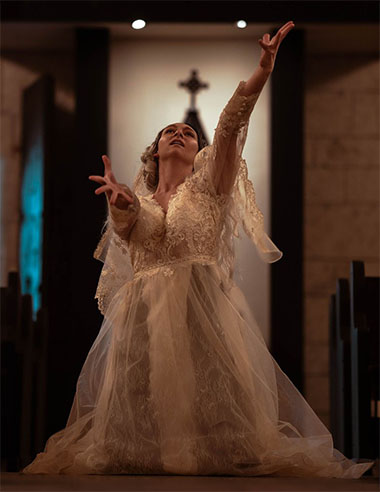
From left, Dance NOW! Miami dancers Natalia Uribe Flores as the narrator, Julia Fortin (Young Havisham), Jean Da Silva (her young suitor), Amanda Davis (Older Havisham), Austin Duclos (Estella's lover, Pip), Rae Wilcoxson (Estella), and David Jewett (Drummel, Estella's eventual husband) create the tale of "Havisham." (Photo by Kenny Palacios).
Historic icons beautifully come together as Dance NOW! Miami, co-directed and founded by Hannah Baumgarten and Diego Salterini, presents “Havisham” on Wednesday, Feb. 7 and Thursday, Feb. 8 at the North Miami Beach Ancient Spanish Monastery Foundation.
Choreographed by Baumgarten, the theater dance work introduces audiences to Miss Havisham, a renowned gothic character from the 1861 Charles Dickens novel, “Great Expectations,” in a site-specific piece of love, passion, betrayal and vindication.
The elegant Monastery of St. Bernard de Clairvaux, known today as the Ancient Spanish Monastery Foundation, was originally completed in 1141AD in northern Spain. It was purchased in 1925 by William Randolph Hearst, dismantled stone by stone and shipped to the U.S.
Hearst’s financial problems forced him to abandon the project and sell most of the collection at auction, until the remainder was purchased in 1952, 26 years later, and reassembled to be a "tourist" destination.

Amanda Davis as the forlorn and humiliated Miss Havisham. (Photo by Kenny Palacios)
In 1964, Colonel Robert Pentland Jr. a multimillionaire banker, philanthropist and benefactor of numerous Episcopal churches, purchased the cloister buildings and presented them to the Bishop of Florida. The lovely Monastery and grounds reside today in North Miami Beach as the parish Church of St. Bernard de Clairvaux, having a functioning and growing congregation in the Episcopal Diocese of Southeast Florida.
The Monastery is considered to be the oldest building in the Western Hemisphere.
With the historic buildings and gardens of the Ancient Spanish Monastery Foundation, sets and lighting created by Bruce F. Brown, period costumes with a hint of Spanish flair built by Haydee and Maria Morales, and familiar contemporary and classical songs played live by the South Beach Chamber Ensemble, the perfect ambiance is created to unfold this steamy and mysterious tale as re-imagined by Baumgarten.
“Havisham” is is most likely certain to re-kindle your curiosity and ignite your Dickens exploration.
Miss Havisham is probably one of the most studied, analyzed and certainly, well-known femme fatales in the extensive pool of literary characters. She has been called a witch, vengeful, horrid, skeleton-like, and she is a yearly, scarily immortal Halloween character. Yet, because of the idea that bad behavior can be redeemed, she remains a woman who never fails to incite discussion and controversy.
To tell her story briefly, Miss Havisham was a wealthy, beautiful, educated "catch" of a woman. One would think she had it all. She fell madly in love with Compeyson, a suitor who eventually became her fiancée. Little did Miss Havisham know, Compeyson was only after her money. In a final blow, Miss Havisham is left at the alter by Compeyson; she's alone, no love, no suitor, no future. Humiliated and hurt, she suffers a mental breakdown.
In a crazed statement of remorse, Miss Havisham never takes off her wedding dress, leaves the wedding cake to rot on the feast table, draws the blinds, and has the clocks halted at the exact moment she received Compeyson’s letter of betrayal. She completely freezes the moment in time.

Dancers, Amanda Davis as Miss Havisham with Jean Da Silva and Julia Fortin at the Ancient Spanish Monastery Foundation. (Photo by Kenny Palacios.)
Miss Havisham eventually adopts a daughter, Estella, whom she uses as bait to punish suitors. Sadly, Estella never learns to truly love and her life is ruined. Miss Havisham eventually sees the pain she has caused and asks for forgiveness.
It is a story and a character that Baumgarten has been stewing over for years.
" 'Great Expectations' was the first book I ever read,” says Baumgarten. “and I’ve always had this story in my head. When I was thinking about the project, the Spanish Monastery came to mind. We’ve done a few partnerships with the Monastery . . . and we’ve always wanted to do more there. It is really the absolute perfect setting.”
Presenting “Havisham’ at the Spanish Monastery also gives a little bonus, as Baumgarten says, to the work.
“You know, here in Florida we’re always playing with ‘what is the identity of Floridians?’ Most of us are transplants and the majority are from Latin countries. 76% of people speak Spanish in their homes. It became something that I could play with, adding little Spanish touches, a narrative that is spoken in both English and Spanish.”
She continues: “While it was a perfect opportunity to represent something old, it also represents something multi-cultural, the way we are all blended here.”
Baumgarten’s goal is to create a backstory. She is exploring what Havisham’s love was like, the passion she felt. How and why did she become this evil character? The book doesn’t let us in on these details

"Havisham" dancers, from left, Rae Wilcoxson, Amanda Davis, and Austin Duclos. (Photo by Kenny Palacios)
While "Great Expectations” is a well-known Dickens novel, it is not necessarily in the canon of literature here in South Florida schools. Many people have not grown up with the story.
“There are few words in both Spanish and English that introduce the moments of what happens,” says Baumgarten.
She did research with a psychoanalyst to accurately understand and decipher Miss Havisham and discovered that there is a technical term for this dysfunctional scenario, called transgenerational transference of trauma. Displacement of anger is a challenging problem, even in today’s world.
“The purpose of my story is not to reiterate her horribleness,”says Baumgarten says. “It is to try to shed some compassion on her. I wanted to give, maybe, some more humanity to her. She’s not even given a first name.”
Laughingly Baumgarten says, “She’s one of the most hated characters in English literature.”
The choreographer also believes her work can resonate with current state of affairs.
“There are horrible things going on in the world,” says Baumgarten. “People are consumed with pain that hurts others. Miss Havisham was a strong and probably very capable woman who was hurt deeply. She was completely a victim of the circumstances and turned into an awful person because of it and she continued to perpetrate hurt not only on others, but through others. She weaponizes her daughter to hurt men forever and ever. And in doing so, she destroys lives.”
The journey, as told by Baumgarten, starts in the culmination of the story. It will then go back in time to the backstory that she has created. It tells of the unbelievable romance that whisks Miss Havisham off her feet causing her to give in to the promise of love.
Salterini, growing up in Rome, was not familiar with “Great Expectations” and the story of Miss Havisham.
He says he is enjoying watching Baumgarten develop the piece and is offering suggestions here and there.

The suitor, Jean Da Silva with the young Miss Havisham, Julia Fortin. (Photo by Kenny Palacios)
“Knowing what she (Baumgarten) is wanting to convey, I can suggest to look at it in ‘this’ way to convey that idea. I work in the immediate, not on the overall project. It’s all in her brain and in her heart,” says Salterini. “But the best part is that I get to sit and watch.”
Baumgarten jumps in, “I think it’s been extremely beneficial that he hasn’t known the story well. Diego keeps me aware of staying clear and simple.”
Baumgarten is very direct in saying that Miss Havisham is an archetype and that Dickens was very deliberate in his creation of her character, even to the fact of not giving her a first name.
“In the piece,” says Baumgarten, “ you will see her lose it. She goes from ultimate love to ultimate pain and we start to understand how she became who she was. And in the end, she asks for forgiveness and tries to fix everything that she’s done.”
She paused.
“But she can’t quite do it.”
Life imitates art and art imitates life.
"Dance Now! presents “Havisham" at 6:30 and 8 p.m. on Wednesday, Feb. 7 and Thursday, Feb. 8 at the Ancient Spanish Monastery Foundation 16711 West Dixie Highway, North Miami Beach. Tickets are $25 / $15 Students with valid ID. Onlyl 50 spaces are available per show. For more information, contact dancenowmiami.org. 305-9758489 (DNM) or 305-610-3567 (ASM)




